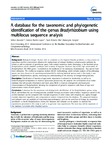Use este identificador para citar ou linkar para este item:
http://www.alice.cnptia.embrapa.br/alice/handle/doc/1018160Registro completo de metadados
| Campo DC | Valor | Idioma |
|---|---|---|
| dc.contributor.author | AZEVEDO, H. | pt_BR |
| dc.contributor.author | LOPES, F. M. | pt_BR |
| dc.contributor.author | SILLA, P. R. | pt_BR |
| dc.contributor.author | HUNGRIA, M. | pt_BR |
| dc.date.accessioned | 2015-06-19T11:11:11Z | pt_BR |
| dc.date.available | 2015-06-19T11:11:11Z | pt_BR |
| dc.date.created | 2015-06-19 | pt_BR |
| dc.date.issued | 2015 | pt_BR |
| dc.identifier.citation | BMC Genomics, London, v. 16, 2015. Suppl 5, S10. | pt_BR |
| dc.identifier.issn | 1471-2164 | pt_BR |
| dc.identifier.uri | http://www.alice.cnptia.embrapa.br/alice/handle/doc/1018160 | pt_BR |
| dc.description | Biological nitrogen fixation, with an emphasis on the legume-rhizobia symbiosis, is a key process for agriculture and the environment, allowing the replacement of nitrogen fertilizers, reducing water pollution by nitrate as well as emission of greenhouse gases. Soils contain numerous strains belonging to the bacterial genus Bradyrhizobium, which establish symbioses with a variety of legumes. However, due to the high conservation of Bradyrhizobium 16S rRNA genes - considered as the backbone of the taxonomy of prokaryotes - few species have been delineated. The multilocus sequence analysis (MLSA) methodology, which includes analysis of housekeeping genes, has been shown to be promising and powerful for defining bacterial species, and, in this study, it was applied to Bradyrhizobium, species, increasing our understanding of the diversity of nitrogen-fixing bacteria. Description: Classification of bacteria of agronomic importance is relevant to biodiversity, as well as to biotechnological manipulation to improve agricultural productivity. We propose the construction of an online database that will provide information and tools using MLSA to improve phylogenetic and taxonomic characterization of Bradyrhizobium, allowing the comparison of genomic sequences with those of type and representative strains of each species. Conclusion: A database for the taxonomic and phylogenetic identification of the Bradyrhizobium, genus, using MLSA, will facilitate the use of biological data available through an intuitive web interface. Sequences stored in the on-line database can be compared with multiple sequences of other strains with simplicity and agility through multiple alignment algorithms and computational routines integrated into the database. The proposed database and software tools are available at http://mlsa.cnpso.embrapa.br, and can be used, free of charge, by researchers worldwide to classify Bradyrhizobium, strains; the database and software can be applied to replicate the experiments presented in this study as well as to generate new experiments. The next step will be expansion of the database to include other rhizobial species. | pt_BR |
| dc.language.iso | eng | eng |
| dc.rights | openAccess | eng |
| dc.title | A database for the taxonomic and phylogenetic identification of the genus Bradyrhizobium using multilocus sequence analysis. | pt_BR |
| dc.type | Artigo de periódico | pt_BR |
| dc.date.updated | 2017-05-11T11:11:11Z | pt_BR |
| dc.subject.thesagro | Fixação de nitrogênio | pt_BR |
| dc.subject.nalthesaurus | Nitrogen fixation | pt_BR |
| dc.description.notes | Edição dos Proceedings of the 10th International Conference of the Brazilian Association for Bioinformatics and Computational Biology (X-Meeting 2014), Belo Horizonte, Oct. 2014. | pt_BR |
| dc.format.extent2 | 11 p. | pt_BR |
| riaa.ainfo.id | 1018160 | pt_BR |
| riaa.ainfo.lastupdate | 2017-05-11 | pt_BR |
| dc.contributor.institution | HELTON DE AZEVEDO, CNPSO; Fabricio Martins Lopes; PAULO ROBERTO SILLA, CNPSO; MARIANGELA HUNGRIA DA CUNHA, CNPSO. | pt_BR |
| Aparece nas coleções: | Artigo em periódico indexado (CNPSO)  | |
Arquivos associados a este item:
| Arquivo | Descrição | Tamanho | Formato | |
|---|---|---|---|---|
| Adatabaseforthetaxonomicandphylogenetic.pdf | 1.24 MB | Adobe PDF |  Visualizar/Abrir |









